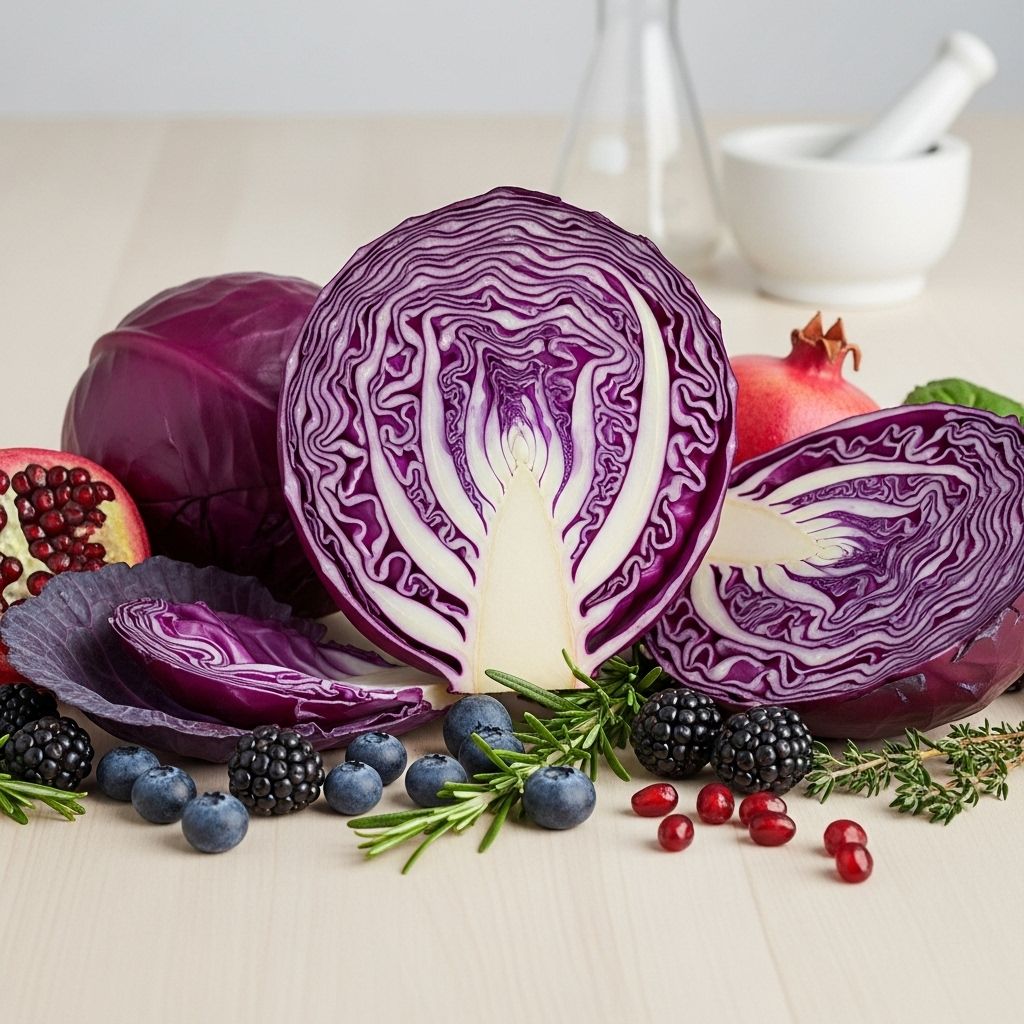13 Powerful Health Benefits Of Red Cabbage: Nutrition, Uses, And More
Crunchy, fiber-rich superfood packed with antioxidants to support digestion and immunity.

Red cabbage, also known as purple cabbage, is a vibrant member of the Brassica family, sharing its lineage with renowned nutrient-rich vegetables like broccoli, kale, and Brussels sprouts. This crunchy and peppery vegetable is far more than just a colorful addition to salads—it is packed with nutrients and bioactive compounds that support holistic wellbeing. Read on to discover 13 compelling health benefits of red cabbage, its nutritional breakdown, potential side effects, and answers to common questions.
What Is Red Cabbage?
Red cabbage (Brassica oleracea var. capitata) is a close relative of green cabbage, with a striking reddish-purple hue thanks to its high content of anthocyanins. Originating in Europe, red cabbage is now cultivated across the world and commonly found in salads, slaws, stir-fries, and fermented foods like sauerkraut and kimchi.
Red cabbage has a dense head formed by tightly packed leaves and offers a crunchy texture when eaten raw. Cooking it brings out a sweeter, softer taste. Its vibrant color is not only eye-catching but signals the presence of potent antioxidants that offer unique health advantages.
Red Cabbage Nutrition Facts
| Nutrient | Amount |
|---|---|
| Calories | 28 kcal |
| Protein | 1 g |
| Carbohydrate | 7 g |
| Fiber | 2 g |
| Potassium | 104 mg |
| Vitamin C | 56% Daily Value (DV) |
| Vitamin K | 28% DV |
| Vitamin B6 | 11% DV |
| Vitamin A | 6% DV |
| Thiamine (B1) | 5% DV |
| Riboflavin (B2) | 5% DV |
| Calcium | 40 mg |
| Iron | 0.47 mg |
Red cabbage is a low-calorie, nutrient-dense food that provides a spectrum of vitamins, minerals, and health-promoting phytochemicals.
13 Science-Backed Health Benefits Of Red Cabbage
Let’s explore the top evidence-based health advantages of adding red cabbage to your diet.
1. Rich In Protective Antioxidants
The deep purple color of red cabbage comes from anthocyanins—powerful flavonoid antioxidants that protect cells against oxidative stress and damage. Red cabbage contains higher quantities of these compounds than green cabbage, contributing to its superior antioxidant capacity. This helps the body counteract free radicals, which are implicated in aging and chronic diseases.
2. May Support Heart Health
- Anthocyanins and other polyphenols in red cabbage are linked to reduced risk of heart disease.
- Regular intake may lower blood pressure, support blood vessel function, and reduce cholesterol levels.
Scientific evidence points to a positive relationship between anthocyanin-rich diets and cardiovascular health, including lower rates of heart attacks and heart disease-related deaths.
3. Helps Fight Inflammation
Red cabbage is abundant in sulforaphane, a sulfur-containing phytochemical that is activated when the vegetable is chopped or chewed. Sulforaphane possesses strong anti-inflammatory effects, reducing markers of inflammation and protecting the gut and cardiovascular system.
4. May Exhibit Anti-Cancer Properties
- Red cabbage contains cancer-fighting compounds such as anthocyanins, glucosinolates, and sulforaphane.
- These compounds help prevent oxidative DNA damage and inhibit cancer cell proliferation.
While no single food can prevent cancer, diets rich in cruciferous vegetables like red cabbage are associated with a lower risk, especially for colorectal and breast cancers.
5. Boosts Gut Health
Red cabbage provides both soluble and insoluble dietary fiber, acting as a prebiotic to nourish beneficial gut bacteria. Isothiocyanates in red cabbage stimulate the production of short-chain fatty acids (SCFAs) in the colon, which support gut lining integrity and overall digestive health.
6. Supports Bone Health
- Vitamin K (28% DV per cup) plays a crucial role in bone metabolism and calcium utilization.
- Red cabbage also supplies minerals like calcium, magnesium, and copper important for strong bones.
Regular consumption of vitamin K-rich foods like red cabbage may reduce bone loss and the risk of osteoporosis.
7. Aids Weight Loss And Management
Low in calories and high in fiber, red cabbage is ideal for those looking to maintain or reduce weight. Its fiber content increases satiety and helps control hunger, making it easy to include in calorie-controlled meal plans.
8. Provides Immune Boost
- One serving delivers more than half your daily vitamin C needs—an essential nutrient for immune defense, wound healing, and collagen production.
- Antioxidants further defend against pathogens and infection.
9. May Improve Brain Health
The antioxidants in red cabbage may shield brain cells from oxidative damage, potentially lowering the risk of neurodegenerative conditions and supporting cognitive function. Anthocyanins have been associated with slower age-related mental decline.
10. Supports Healthy Skin
- Vitamin C and antioxidants in red cabbage contribute to the synthesis of collagen, vital for skin elasticity and strength.
- Frequent intake may help reduce skin aging and promote a healthy complexion.
11. Improves Eye Health
Red cabbage contains vitamin A and carotenoids, crucial for maintaining healthy vision. Antioxidants help prevent macular degeneration and support eye tissue against free radical damage.
12. May Enhance Lifespan
Preclinical research indicates that red cabbage juice may significantly increase survival during stress and prolong lifespan in experimental organisms, likely due to its rich content of anthocyanins and other phenolics. These results await further confirmation in human studies.
13. Versatile And Easy To Add To Diet
- Red cabbage can be enjoyed raw in salads and slaws, cooked in stir-fries, soups, or braised with fruit and spices.
- Fermented red cabbage (sauerkraut, kimchi) delivers probiotics, further benefiting gut and immune health.
How To Add Red Cabbage To Your Meals
- Raw: Shred for crunchy salads, coleslaw, wraps, or sandwiches.
- Cooked: Braise with apples and spices, add to stir-fries, soups, or casseroles.
- Fermented: Make sauerkraut or kimchi for a probiotic boost.
- Pickled: Quick-pickle for a tangy condiment on tacos, burgers, or rice bowls.
- Juiced: Blend with other veggies or fruits for an antioxidant-rich drink.
Potential Side Effects And Precautions
- Digestive Issues: Excess intake may cause gas, bloating, or mild discomfort in sensitive individuals due to its fiber content.
- Thyroid Function: Raw cruciferous vegetables like red cabbage contain goitrogens that may interfere with thyroid hormone production, especially in people with thyroid disorders. Cooking reduces this risk.
- Medication Interaction: Those on blood thinners should monitor vitamin K intake, which can affect medication efficacy.
Frequently Asked Questions (FAQs)
Q: Is red cabbage healthier than green cabbage?
A: Yes. Red cabbage contains higher levels of anthocyanins, vitamin C, and certain antioxidant compounds relative to green cabbage, providing greater protective effects against oxidative stress and disease.
Q: Can red cabbage be eaten raw?
A: Absolutely. Red cabbage is delicious raw in salads and slaws, offering maximum crunch and preserving heat-sensitive nutrients like vitamin C and sulforaphane.
Q: Does cooking affect red cabbage’s nutrition?
A: Yes. Cooking softens its texture and enhances sweetness, but some water-soluble vitamins (especially vitamin C) may decrease. Light steaming helps retain most nutrients.
Q: How does red cabbage promote gut health?
A: Its high insoluble fiber promotes regularity, while prebiotic fibers act as fuel for beneficial gut bacteria. Fermented red cabbage delivers additional probiotic benefits for digestive and immune health.
Q: Is red cabbage safe for everyone?
A: Yes, for most healthy individuals. Those sensitive to fiber or with thyroid concerns should moderate intake, especially of raw cabbage.
Conclusion
Red cabbage stands out as a nutrition powerhouse and functional food with impressive antioxidant, anti-inflammatory, and anti-cancer properties. Adding red cabbage to your diet not only provides a vibrant splash of color and crunch but also supports heart, bone, digestive, and immune health. Its versatility lets you explore raw, cooked, and fermented preparations for optimal benefits. As with any vegetable, moderation and variety are key to enjoying all its advantages safely.
Embrace red cabbage as part of a balanced, colorful diet to harness nature’s protective gifts in every bite.
References
- https://www.bbcgoodfood.com/health/nutrition/health-benefits-red-cabbage
- https://www.healthline.com/nutrition/purple-cabbage
- https://pmc.ncbi.nlm.nih.gov/articles/PMC8228718/
- https://nutritionfacts.org/topics/cabbage/
- https://www.health.harvard.edu/heart-health/vegetable-of-the-month-red-cabbage
- https://foodstruct.com/nutrition-comparison/cabbage-vs-red-cabbage
- https://www.brownhealth.org/be-well/cabbage-and-benefits-overlooked-superfood
- https://wildbrine.com/napa-green-red-cabbage-nutrition/
Read full bio of medha deb












